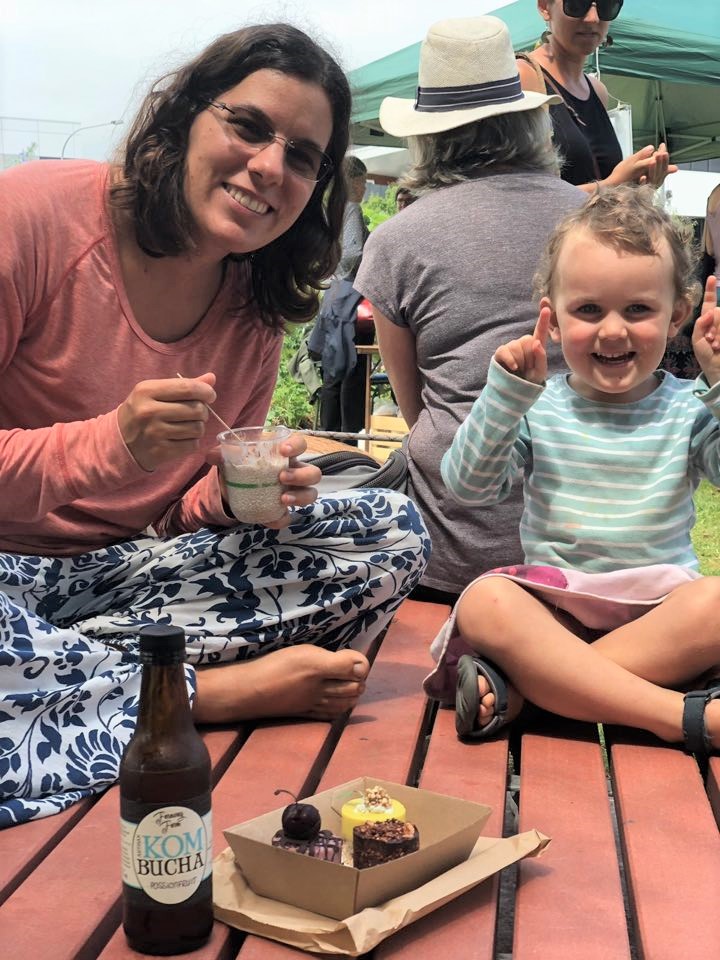
Regular market customers Anne [second from left] and Rod [second from right] chat with friends on market day. Photo: Elka Wood.
The weekly Friday market is centrally located in Bega’s Littleton Gardens and it even has a stall which will sell your excess produce for you for a small commission.
So why, so often, does a view of the market show only three or four stalls, a food van and a smattering of people?
The poor showing of Bega’s market is especially confusing to those people who remember the origins of the market when sausages sizzled, a coffee van did steady business and stalls offered services such as knife sharpening, hairdressing or massages as well as local produce.
“I do wonder … why are there not more people?” asks market coordinator Sue Hill.
Partly, the answer lies in the nature of the conditional agreement between SCPA – South East Producers, who run the market and with Bega Valley Shire Council who manage Littleton Gardens.
“Council wanted us to not have services and only produce from 250 km away,” explains Hill. “They also require us to move the market every two months because of concerns about wear to the grass.”

Sue Hill volunteers her time as market coordinator of the Bega SCPA – South East Producers market. In front of Hill is an empty food container made from compostable plastic. The market aims to be waste-free. Photo: Elka Wood.
SCPA President, Paul McMurray says that the market’s main goal is to “grow the grower,” but that “we’ve got a bit of a chook and egg situation here – to make the market interesting to customers, we need more growers, but to make the market look profitable to growers, we need more people.”
A history of concern from the Chamber Of Commerce about the market impacting negatively on Bega business has not helped the market grow, despite, according to Hill and former market coordinator Geoffrey Grigg, asking every business on Bega’s main street whether market days helped or hindered business and receiving a resoundingly positive response.
“One business abstained from commenting, but every other business we approached said market day was a busy day for them,” says McMurry.

Lisa Arlid and her daughter Sierra enjoy some treats from Nicky Harris and Chris Aikin’s food van, which specialises in fermented products. Photo: Supplied.
Hill has been the market coordinator for three years and, like all the SCPA members who help put the market together every week, she is a volunteer.
Hill believes the answer to growing the market lies in education – that if everyone understood the impacts of food miles and the ecological footprint, they would buy their food at the market, however limited the selection.
“I have to do this for the planet,” Hills says passionately of the hours she spends on the market, “because I know the climate is changing and the one way we can really make an impact is through our shopping.”
McMurry, however, believes the message ‘support local growers’ must be carefully presented so as not to imply judgment.

Paul McMurry serves customers at Bega’s SCPA market. Photo: Elka Wood.
“We have to attract people here,” McMurry says with a grin, “and we’re probably not going to do that by criticising their lifestyle.”
Rod and Anne are retired and visit the market almost every Friday.
“It’s not sort of… taken off, has it?” Rod muses of the market. “I’d love to come here and see people queuing up for Paul’s veggies. I think it’s because of the time – if I wasn’t retired, there’s no way I would make it on a Friday morning.”
Regular stallholder Jareem says although the market often looks empty, there is a core of “good regular customers,” like Anne and Rod.
“But it’s not that ‘meet ya for coffee,’ big crowd feeling is it?” Jareem says, surveying the few people sitting in the shade in the centre of the market.

Bega’s market may only have a handful of stalls, but it has some “good regular customers,” says stallholder Jareem. Photo: Elka Wood.
Council’s Economic Development Manager, Daniel Murphy, says there is a need to get more people interested in the future of the market and offered the award-winning Moruya SAGE Farmers Market as an example of a successful, producer-led market.
“It might be time to get partners around the table and see what the issues and opportunities are, “Murphy says.
Jareem, commenting on the low numbers of customers, says that perhaps the opening of whole-foods-type shops in Bermagui, Cobargo and Pambula has meant fewer people travel to Bega to shop organic, local, and waste-free.
Then he smiles and asks “or is it really as simple as the market having a coffee machine?”
Bega’s Farmer’s Market – what does it need to really fire in 2019 and beyond? What would make you go?







